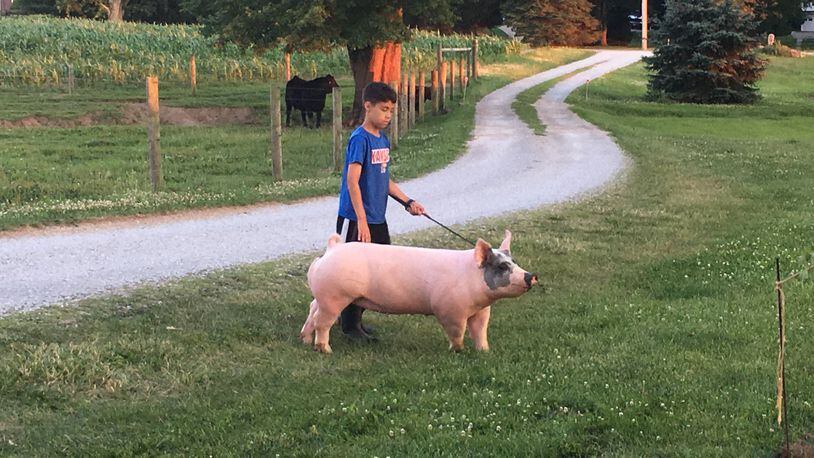RELATED: If swine flu breaks out, pigs at Clark County Fair may face terminal sale
But this year things are different. Our 11-year-old son, who is the most animal-loving child I have ever met, has Some Pig. Is she a grand champion? Probably not, but she has attracted the attention of a breeder, maybe two.
“That’s kind of like winning first place,” our son told us.
This is a game changer for him. The idea of his beloved BatPig becoming a mama is intriguing to him. He always works hard on his projects, but he has doubled his efforts this year feeding and walking his gilt. If BatPig does well at the Clark County Fair, she might get to come home. Best. Fair. Ever. Right?
Enter the Clinton County Fair and a confirmed diagnosis of the H3N2v swine influenza in Ohio. The Centers for Disease Control and Prevention defines the swine flu as a respiratory disease of pigs caused by type A influenza virus that regularly causes outbreaks of influenza in pigs.
The CDC also says swine flu viruses can cause high levels of illness in pig herds but cause few deaths in pigs; and swine flu viruses rarely infect humans.
As my family and friends can attest to, I am a germophobe. Hand washing is rule Numero Uno in our house, especially after spending time in a barn with animals … or at school with hundreds of other children … or at an airport with thousands of other people from around the globe … or after visiting a medical facility of any kind … or … or … or…
READ MORE: Country star, sharks highlight Clark County Fair entertainment
What frightens me more than the swine flu? The mass hysteria surrounding it. The chances of contracting the swine flu, or any flu, can be minimized — there is never a guarantee, of course — but by adhering to simple, common sense guidelines, one can be proactive in avoiding the virus.
OH-Pigs, the Ohio summer show circuit, said on July 15, “We encourage everyone interacting with pigs to wash your hands often to protect both yourself and the pigs. It is also important to know that pork and pork products are safe. According to the CDC, consumers cannot catch the flu from eating or handling pork.”
The CDC urges caution to those who are at high risk for serious complications from flu, including variant flu viruses like H3N2v, including children younger than 5-years-old, people with certain long-term health conditions like asthma and other lung diseases, diabetes, heart disease, weakened immune systems, neurological or neurodevelopmental conditions, pregnant women and people 65 years and older.
DETAILS: Clark County Fair to see big changes at animal auctions this year
Precautions recommended by the CDC include:
• Don’t eat or drink or put anything in your mouth in the pig barn and show arena.
• Don’t take toys, pacifiers, cups, bottles, strollers or similar items into the pig barn and show arenas.
• Wash your hands often with soap and running water before and after exposure to pigs. If soap and water are not available, use an alcohol-based hand rub.
• If you are sick with flu-like illness, stay home to avoid spreading your illness.
The Clinton County Fair hog barn went into a state-mandated quarantine following the confirmed swine flu diagnosis and remained closed to the public for the remainder of the fair. About 300 hogs were ordered to be slaughtered, including those intended to return home for breeding or for competition at the Ohio State Fair. A sad day indeed for these exhibitors and their families.
As the Clark County Fair looms near, please be sure to follow the health protocols set by the CDC. These common-sense guidelines apply to all livestock barns at every agricultural event.
4-H and FFA participants, please be considerate of others and don’t bring unhealthy animals to the fair. Fair patrons, please come enjoy the Clark County Fair but if you have concerns about contracting a virus, please err on the side of caution and avoid the livestock barns.
It’s the job of the Ohio Department of Agriculture Division of Animal Health to protect and promote the health of Ohio’s livestock and poultry industries; including livestock and poultry testing and inspection, licensing, controlling animal diseases in Ohio, and providing veterinary diagnostic laboratory services. The division is also responsible for supervision of exhibition livestock testing.
I get it. Public safety is priority. I have tried to explain this to my son. If the Clark County Fair officials decide to call the show “terminal” before the fair begins, my son has already decided not to show his market hog and take the opportunity to learn about the breeding process alongside his 4-H adviser.
Should fair officials not call the show “terminal” prior to the start of the fair, my son takes the risk of a sick animal at the fair determining the fate of his potential future project. It’s quite a predicament for him; a total crap shoot. Had my son opted for a market hog barrow, we wouldn’t be in this predicament (*duly noted for future projects).
It’s a lot of heartache for a kid to make this choice, but really, none of this risk is new for livestock participants. At any given time, there is a chance for some kind diagnosis at every livestock show, county fair, or farm operation — big or small — across the country. It is why bio-security is a major component to farming.
What is meant to be, will be, but here’s hoping that the 70th anniversary of the Clark County Fair is healthy, safe, fun and memorable for all people and animals.
About the Author
